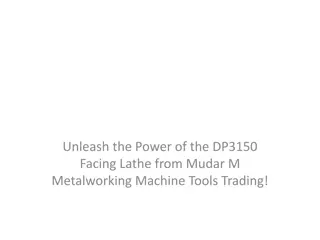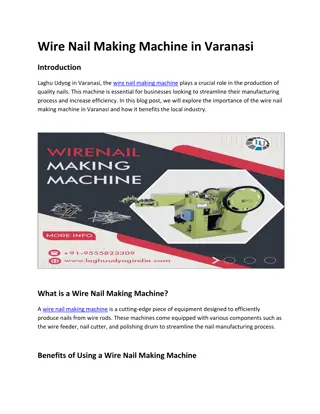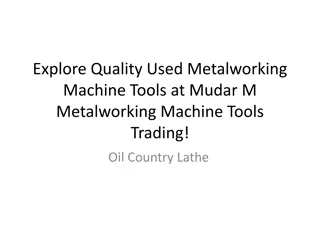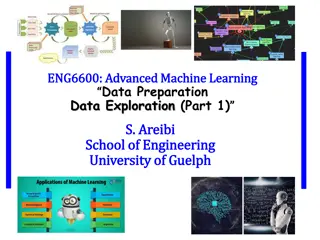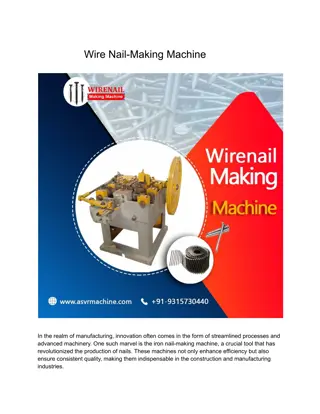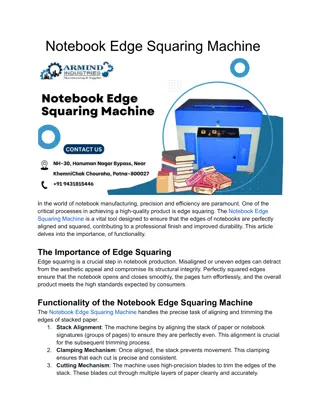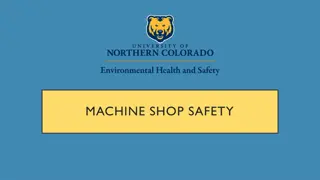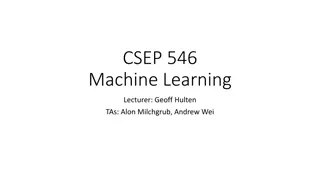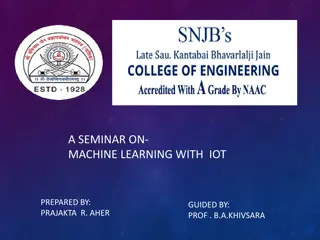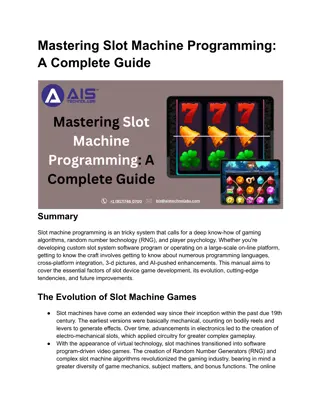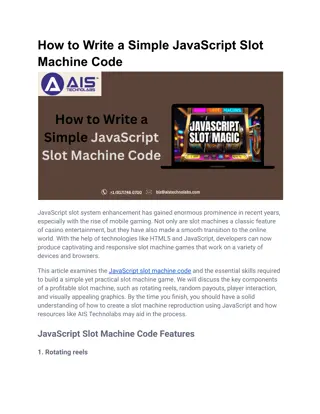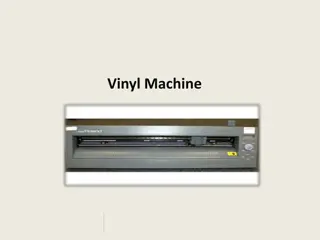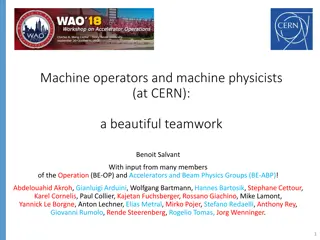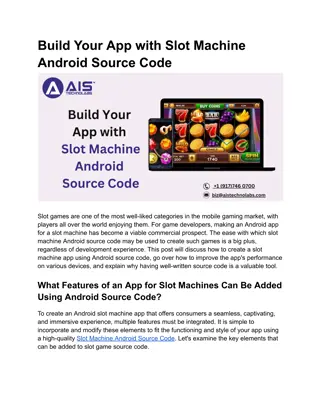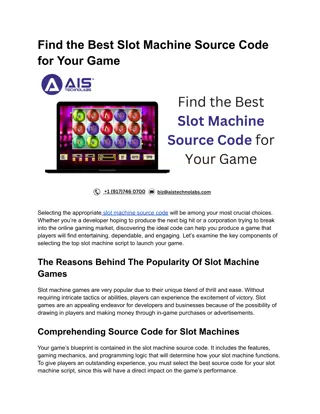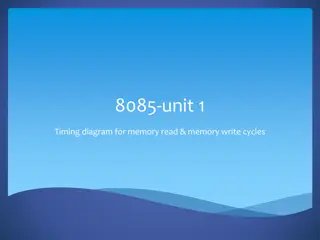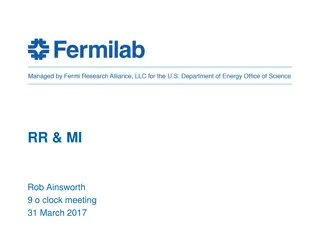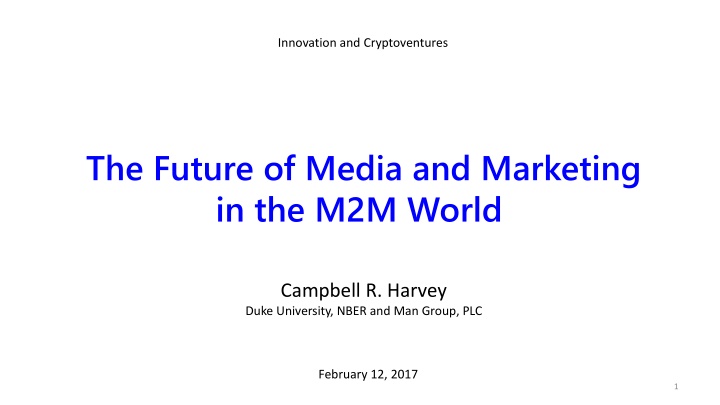
Revolutionizing Media and Marketing in the M2M Era
Explore the evolution of media and marketing, from newspaper monopolies to the impact of Radio, TV, and the Internet. Discover how machine-to-machine payments are reshaping the landscape, as discussed by Campbell R. Harvey in 2017.
Download Presentation

Please find below an Image/Link to download the presentation.
The content on the website is provided AS IS for your information and personal use only. It may not be sold, licensed, or shared on other websites without obtaining consent from the author. If you encounter any issues during the download, it is possible that the publisher has removed the file from their server.
You are allowed to download the files provided on this website for personal or commercial use, subject to the condition that they are used lawfully. All files are the property of their respective owners.
The content on the website is provided AS IS for your information and personal use only. It may not be sold, licensed, or shared on other websites without obtaining consent from the author.
E N D
Presentation Transcript
Innovation and Cryptoventures The Future of Media and Marketing in the M2M World Campbell R. Harvey Duke University, NBER and Man Group, PLC February 12, 2017 1
The Plan M2M = Machine to Machine The history of media and marketing and its disruption How machine to machine payments will change the landscape Campbell R. Harvey 2017 2
The Newspaper Newspapers held a monopoly over news for more than two centuries. Newspaper operations required large fixed cost investments (printing plant), delivery facilities, advertising staff, collection facilities, as well as editorial. Variables costs such as newsprint were also high. While, at least early on, there was plenty of competition within large urban areas, advertising was priced at a premium ensuring newspapers were very profitable. Campbell R. Harvey 2017 3
The Newspaper Newspapers held a monopoly on news for over two centuries. Given the high fixed costs and the barriers to entry, newspapers catered to the general interests of a broad constituency (mass market) and this is the genesis of the great metropolitan newspaper . While there was some very broad differentiation (mainly along class or political lines), the newspaper was a push product (essentially everyone got the same content and you chose to read the content you were interested in). Campbell R. Harvey 2017 4
The Newspaper Newspapers held a monopoly on news for over two centuries. The fragmentation of newspapers into niche areas was not possible given the high fixed costs of production and distribution These fixed costs were an effective barrier to entry Campbell R. Harvey 2017 5
Competition from Radio and TV In the 20th century, two competitors emerged to the newspaper monopoly Radio and TV lured some time away from newspaper readers. However, Radio and TV never really made much of a dent in the news gathering function. Indeed, Radio and TV would largely rely on news from newspapers to set their broadcast news content. In addition, much more detail was possible in print than audio or visual. Importantly, Radio and TV did not disrupt newspapers (which were very profitable until about 2001). Campbell R. Harvey 2017 6
The Internet In the mid-1990s, the world wide web made the Internet broadly accessible to the general public. Some of the earliest websites were newspaper websites (New York Times in January 1996). These sites essentially repurposed the print content into a website. Readers had an option to view content as hard copy or on line. All content was free. Campbell R. Harvey 2017 7
The disruption The Internet enabled niche and tailored content In the past, if you were thinking of starting a newspaper, radio station, or even a television station with highly specialized content, it was too expensive to launch. The Internet solved the production problem (cheap, just need a web editor), delivery mechanism (free), collection function (everything is free), low variable costs (no newsprint), leaving only a need for editorial, advertising, and technology staff. The ease of production and distribution are the main disruptive mechanisms. Newspapers, in general, failed to understand the nature and implications of the disruption.Campbell R. Harvey 2017 8
The implications of the disruption There were at least five implications of the disruption 1. New competition Niche publications become competitors. These specialized publications could be a single person writing a blog. Extra-metro area content providers such as the New York Times provided direct competition to traditional metropolitan newspapers. The lines blurred between alternative media outlets because television news sites like CNN, CNBC, were directly competing against traditional newspaper news sites. In some countries, the fiercest on-line competition came from government sponsored entities such as the BBC (UK) and the CBC (Canada). Campbell R. Harvey 2017 9
The implications of the disruption There were at least five implications of the disruption 2. Pull vs. Push In the past, readers would select the pages they would read in the newspaper which meant the newspaper would have to be very general, mass market oriented. The Internet allowed viewers to easily pull content on topics that they were interested from many different sources. Given that the great metropolitan newspapers were doing everything , they were vulnerable to specialized publications that were doing a better job on specific topics. Campbell R. Harvey 2017 10
The implications of the disruption There were at least five implications of the disruption 3. The advertising model fell apart As readers migrated to different content providers, it became impossible for newspapers to keep up the traditional line rates. In addition, there was a basic economic reality: the on-line outlets had far lower costs than the print newspapers and they could afford to charge a lower rate. In 2003, US newspapers had $1.2B in digital revenue , Google had $1.2B, and Facebook didn t exist. In 2015, US newspapers had $3.5B in digital revenue, Google had $68B and Facebook $17.1B. Current projections suggest that these two companies will capture 80% of the growth in digital advertising over the next few years. http://trafficmagazine.com/2016/09/22/the-online-ad-oligarchy/ Campbell R. Harvey 2017 11
The implications of the disruption There were at least five implications 3. The advertising model fell apart Google on track for $90b in advertising revenue in 2016 mainly via Adwords Highest CPC (cost per click) is over $900. Campbell R. Harvey 2017 12 https://searchenginewatch.com/2016/05/31/the-most-expensive-100-google-adwords-keywords-in-the-us/
The implications of the disruption There were at least five implications 3. The advertising model fell apart Google on track for $90b in advertising revenue in 2016 mainly via Adwords Highest CPC (cost per click) is over $900. Consumer does not benefit (company and Google benefit) Campbell R. Harvey 2017 13 http://www.visualcapitalist.com/the-100-most-expensive-keywords-on-google/
The implications of the disruption There were at least five implications of the disruption 4. The paywall attempts failed (generally) Why pay when you can get the equivalent news for free? Why pay a monthly fee for a lot of content that you are not really interested in? (On this point, there is a parallel disruption happening with cord cutters and cord nevers in the cable TV space.) Campbell R. Harvey 2017 14
The implications of the disruption There were at least five implications of the disruption 5. Social media In the last 10 years, the second phase of the Internet kicked in. Originally, the Internet was about sharing information. The second phase of the Internet enabled the building of communities. Newspapers given their focus on a broad population were not able to build communities within their readership. Campbell R. Harvey 2017 15
The current landscape The financial reality It is nearly impossible for newspapers to generate enough advertising revenue (print plus on line) to support print and on line content. The Catch 22: If you cut back on the editorial content to save money, the lower quality will result in lower readership. Many newspapers that were in a weak position went into a death spiral. They were shuttered, consolidated, or are now only a shadow of whom they were. Campbell R. Harvey 2017 16
The current landscape The Balkanization/specialization of viewership News and analysis content is now chosen either by an aggregator (that learns the viewer s preferences), by trusted people (such as Twitter followers), or directly by the reader. Every viewer has a different portfolios of inputs. This is dramatically different than say readers splitting into two groups: Tribune vs. Sun Times. This has implications for political discourse. People are drawn to news sources that reinforce their current beliefs. This helps explain current state of extreme partisanship. Campbell R. Harvey 2017 17
The current landscape Quality of News There are more journalists today than at any point in history. People read more today than at any point in history. While the quantity of news has dramatically increased, many believe the average quality has decreased. Essentially, anyone can become a journalist and in a small operation there are few, if any, editorial quality controls. Campbell R. Harvey 2017 18
The current landscape Fake News Fake news is not new. It has been around since the beginning of newspapers. For example, stories were planted in newspapers to further political agendas. Indeed, I think fake news may be less important today than in the past for two reasons: Given there is so much noise in the news and given the explosion of the amount of news content, the fake news is not very likely to have an impact. Fake news was supposedly an issue during the US election. Given the Balkanization of viewership, this news unlikely changed enough beliefs (fake news catered to those that had already decided who to vote for). Campbell R. Harvey 2017 19
The outlook [optional] The outlook for traditional newspapers is not as grim as you might think assuming that certain crucial steps are taken in the areas: Print vs. on-line Content Monetization Campbell R. Harvey 2017 20
The outlook [optional] Print vs. on line: It does not make sense to shutter print operations if they are still providing positive cash flow. However, it is important to shutter them quickly after the cash flow goes negative. This is a structural not a cyclical change. In the mean time, it is important to prepare for this eventuality and it is a mistake, for example, to sign long-term print contracts Campbell R. Harvey 2017 21
The outlook [optional] Content: The business model of the great metropolitian newspaper has failed. It is time to realize this is permanent and move on. There is no market for a one-stop news site that caters to everyone. Specialize in what you do best. For most metropolitan newspapers, this is local content. With local content, there is no competition from the extra-metro properties like the New York Times. Engage the local community as content providers. You provide the quality control. Create, where possible, social communities around local issues. Campbell R. Harvey 2017 22
The outlook Monetization: It is a fact that the on line advertising revenue will not fill the historical gap from the print advertising revenue. The current paid subscription for print copies will go to zero as the print copy disappears. Viewers do not want to pay a monthly fee for content. There is a solution -- but first I need to talk about advertising. Campbell R. Harvey 2017 23
Advertising Traditional model Take an ad out in a newspaper. Given that the newspaper was the only source of news, your target audience likely would see the ad. With emergence of Radio and TV, the advertisers could be more selective and target specific audiences. Some specialized trader publications targeted select audiences (like autos) and started to take away traditional classified advertising. Campbell R. Harvey 2017 24
Advertising Differentiation and targeting Modern on line advertising attempts to hone in on the highest probability of purchase customers. Advertisers have the option of advertising in niche sites where there is a high probability of the right viewers. In addition, modern browsers track general characteristics of viewers. Some of the on line real estate is auctioned off to the highest advertising bidder and a specialized ad is pushed at you (matching your on-line characteristics). Campbell R. Harvey 2017 25
Advertising In the future, targeting will be much more precise The information that browsers collect is coarse (but better than nothing). In the future, data science and machine learning will be employed to provide a much finer differentiation. In addition, consumers will opt in by providing detailed demographic information. Why would they do this? Money. Campbell R. Harvey 2017 26
Machine to Machine Payments Three stages of the Internet Initially, a way to gather information (via search or just visiting a website). Next, social media where new communities were enabled by the Internet. Over the next few years, the third wave will be machine to machine payments enabled by the Internet. Campbell R. Harvey 2017 27
Machine to Machine Payments Current payments on the Internet Today, it is possible to pay for things on the Internet. However, the technology is clunky. APIs allow you to enter credit card or bank information. Current payments are only feasible if they are of sufficient size. Merchants face a 3% credit card fee. You need to have a credit card or bank account to play in this space. Campbell R. Harvey 2017 28
Machine to Machine Payments With today s technology, there are severe constraints Consumers pay for things but they cannot be paid. It is infeasible to think about forcing customers to pay, say 5 cents to visit your webpage and it is equally infeasible to think about paying someone to visit your website or ad. Campbell R. Harvey 2017 29
Machine to Machine Payments It is generally not known that machine to machine payments are possible in HTTP they just aren t used. Look up HTTP 402 code (you all know the frequent 404 error website not found). 402 Payment Required Reserved for future use. The original intention was that this code might be used as part of some form of digital cash or micropayment scheme, but that has not happened, and this code is not usually used. https://en.wikipedia.org/wiki/List_of_HTTP_status_codes Campbell R. Harvey 2017 30
Machine to Machine Payments It is generally not known that machine to machine payments are possible in HTTP they just aren t used. It is feasible to exchange funds (instantly, seamlessly, and securely) in a secure way using a digital cryptocurrency in the background using current blockchain technology. 21.co is the leading company in this space and they are well funded by one of the most highly-respected venture capital firms in the world, A16Z Campbell R. Harvey 2017 31
Machine to Machine Payments Tasks and demographic information Amazon Turk has essentially farmed out tasks. However, they operate in only two countries (U.S. and India) and payments for the tasks are made once a month. Using HTTP combined with a cryptocurrency wallet, the payments are instant. Further, you do not need a traditional bank account. Think of getting into an Uber and completing a few surveys during your ride. For each survey, you get $2.50. Enough to pay for the Uber. Some of these tasks are explicitly learning about your preferences. That is, you are offering up your demographic profile. Campbell R. Harvey 2017 32
Machine to Machine Payments A new way to think about email At the top of your inbox are emails from your work, friends and family. However, companies pay you to accept email from them. The highest paying company will have the highest placement in your inbox. If you open the email, you are also paid. If you click on a link in the email, you may be paid more. Campbell R. Harvey 2017 33
Machine to Machine Payments Email is no longer free Everybody pays to send an email. If I am sending to a friend, the fee is very low, say 1/10 of a cent. Companies will pay far more if my demographic profile is attractive to the company. As a side benefit, spam is eliminated. Over half of all Internet email traffic is spam today. In terms of the economics, it is never efficient to price something at zero. Campbell R. Harvey 2017 34
Machine to Machine Payments The web is no longer free In this world, almost every site you visit you pay a small fee. The fee is so small that it does not deter even the poorest user in Africa. While small, this fee puts the entities that engage in DDoS attacks out of business freeing up about one third of the current bandwidth. Campbell R. Harvey 2017 35
Machine to Machine Payments Revisiting the advertising model Highly targeted advertising pays people to visit websites. When people explore the websites, there could be further payments. Some companies are experimenting with crude versions of this strategy by awarding points if you fill out surveys (that reveal demographic information). There is still some runway for specialized news sites to attract vertical on line advertising However, in the longer term, advertisers will go directly to the consumer because the consumer will invite them. Campbell R. Harvey 2017 36
Machine to Machine Payments Monetizing the news model This same technology allows news content to be monetized. Viewers don t mind paying a few cents in the background to read a quality story as long as it is easy (and machine to machine is seamless) Content providers have direct control over the price of their content (they can differentially price based upon how stale the news is, the location of the user, the time of the day) and, crucially, they know who their readers are. Content providers also welcome aggregators like Google News because a click on the story from Google News is no different than a click from their own website (though Google will like take a small piece of the action) Campbell R. Harvey 2017 37
The future We are currently in a transition state Currently, the economics look very poor and the outlook seems bleak (mainly because people don t understand the implications of machine to machine payments). On line advertising will remain a source of revenue for a number of years but eventually fade as advertisers go directly to consumers. The future is pay for view. At first, the view fees will be low. However, this will provide a new, important, source of revenue. Even with the New York Times (one of the few successful pay walls), 92% of their page views are from non-subscribers. Campbell R. Harvey 2017 38
The future Media: Most newspapers will not survive Given that many newspapers are laden with debt and are not profitable, they are cutting back on quality which provides cash savings in the short term but compromises the chance they can survive in the long run. The companies that will win are those with established large readerships and very little debt (or they have a sponsor, e.g., the Guardian). Campbell R. Harvey 2017 39
The future Media: A new model for the future The remonetizing of the editorial content will allow for continued expenditure on quality control. The market will set the price: People will only pay for quality and the highest quality commands a premium. It is also possible to have a different compensation model for reporters: given them a fraction of the price you charge to read their stories. Campbell R. Harvey 2017 40
The future Advertising and Marketing: A new model for the future Search and keywords will not disappear but it will become much less prominent. It is na ve to think that Google can continue to reap $90b in Adwords revenue they should be paying us to use their service. Traditional agencies will be disrupted by firms that specialize in data science as the level of segmentation reaches the individual level Many companies may not need the traditional agency services they may need consultants to develop their marketing strategies not to implement them Campbell R. Harvey 2017 41
Conclusions M2M payments is a direct result of blockchain innovation It will change the nature of all types media business When combined with advances in data science, it will fundamentally change marketing M2M is not just about marketing and media, as there are many other applications: Cellular towers, pay for view/listen, utility consumption, Campbell R. Harvey 2017 42



